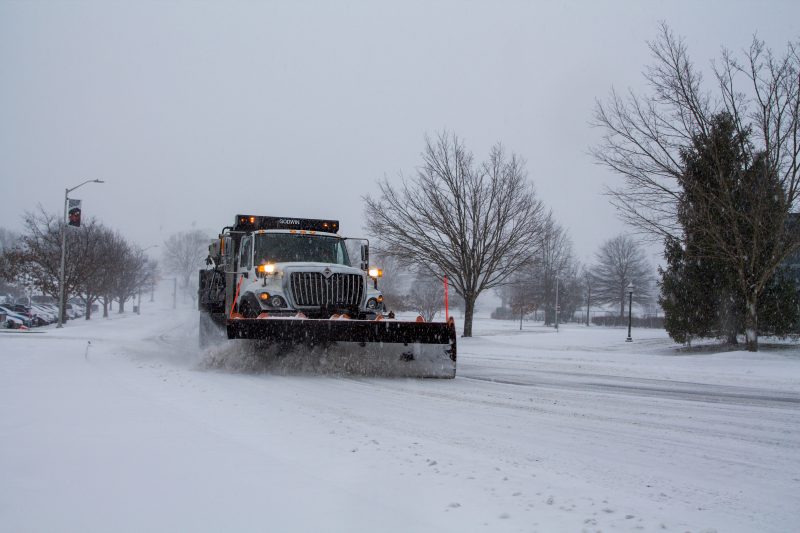
When winter weather approaches Virginia Tech’s campuses, units across the university begin critical preparedness procedures that ensure the safety and well-being of students, employees, and visitors.
In the fall, stakeholders from across the university and surrounding community review the university’s authorized closing policy, make policy updates, and discuss lessons learned from the prior year.
Units represented include Enterprise Administrative and Business Services; the Virginia Tech Police Department; Virginia Tech Emergency Management; Transportation Services; the Division of Campus Planning, Infrastructure, and Facilities; Student Affairs; Services for Students with Disabilities; Housing Services; Dining Services; the Office of the Executive Vice President and Provost; theOffice of the University Registrar; Communications and Marketing; Human Resources; Athletics; the Town of Blacksburg; and Blacksburg Transit.
These stakeholders also examine how Virginia Tech will communicate its winter weather response effectively across all university locations in the commonwealth.
As the potential for a winter storm increases, university officials start watching forecast models and communicating with the National Weather Service to monitor weather across all Virginia Tech locations. This information is shared among university leadership and units across the university. Given conditions will vary across the state, university employees work carefully to monitor the needs and conditions of each Virginia Tech location.
The Virginia Tech community can monitor the latest weather conditions via the weather resources shared on the University Status page for locations across Virginia. Among these resources is WeatherSTEM, Virginia Tech’s own weather monitoring network that provides current weather conditions, updates, and live on-campus cameras.
Depending on the forecast, a snow emergency route notice may be declared on the Blacksburg campus before the storm hits. This means designated roads on campus must remain open for emergency vehicle use and plows. All vehicles parked along these roads must be removed or risk being towed. Snow emergency routes include Alumni Mall, inbound lane only (the outbound lane will remain unaffected); Beamer Way, between Washington Street and Southgate Drive; Kent Street, between Washington Street and Drillfield Drive; South Drillfield Drive, between Kent Street and West Campus Drive (both sides of the road); Wall Street; and Washington Street, between Kent Street and Duck Pond Drive.
The university’s goal is to make decisions as far in advance as available information will allow in order to facilitate subsequent planning and decision-making to impacted operations.
Vice President for Enterprise Administrative and Business Services Lynsay Belshe collects road-condition and readiness reports from university and community organizations including the Virginia Tech Police Department and the Division of Campus Planning, Infrastructure, and Facilities. Executive Vice President and Chief Operating Officer Amy Sebring then decides if any modifications are necessary to university operations on the Blacksburg campus and Virginia Tech facilities in the immediate Blacksburg area.
Modifications to operations in Roanoke, Northern Virginia, Richmond, and other Virginia Tech locations are determined on an individual basis by local police, university emergency management leaders, Communications and Marketing, and other partners.
Communications and Marketing notifies the campus community through the University Status page, VTx Daily News email, social media, and the weather/emergency hotline at 540 231-6668. Virginia Tech Emergency Management will also notify the campus community through the VT Alerts system.
During the storm, the university community is asked to frequently monitor the University Status page for the latest updates impacting all Virginia Tech locations. The university community is also encouraged to download the Hokie Ready App to have fast access to pertinent emergency information and to report emergencies. Those who do not have access to the internet may call the weather/emergency hotline at 540-231-6668.
Employees who have a fully remote or hybrid schedule would be expected to work their normal work schedules at their alternate work sites and would not be eligible for authorized closing leave. Employees should refer to the Authorized Closings Leave and Compensation Policy for questions about working when the university is impacted by inclement weather.
Once winter weather starts, Division of Campus Planning, Infrastructure, and Facilities employees plow roads, loading docks, and service drives in 12-hour shifts. Sidewalks, stairs, parking lots, and streets are also treated when possible before and during the storm with a 23 percent salt brine solution obtained from the tanks at the Virginia Tech Power Plant.
Once the storm is over, teams work tirelessly to widen paths on sidewalks and roads. Contract crews clear parking lots. (Virginia Tech teams try to keep parking lot drive lanes plowed during the storm.) Assigned team members report early, sometimes for days at a time, after a storm to treat any melt that has refrozen.
The ten deepest 24-hour snowfalls in Blacksburg history are 1. 20.4 inches, Jan. 28, 1998 2. 17.8 inches, Jan. 7, 1996 3. 14 inches, Dec. 26, 1969 and March 3, 1960 (tie) 5. 13.4 inches, Jan. 8, 1996 6. 13.3 inches, Dec. 9, 2018 7. 13 inches, March 23, 1981 8. 12 inches Jan. 30, 1966 and March 13, 1993 (tie) 10. 11.3 inches, Feb. 12, 2014.




